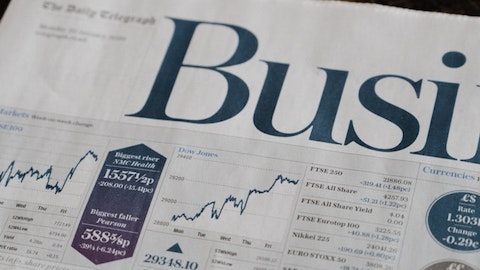Old Second Bancorp, Inc. (NASDAQ:OSBC) Q1 2024 Earnings Call Transcript April 19, 2024
Old Second Bancorp, Inc. isn’t one of the 30 most popular stocks among hedge funds at the end of the third quarter (see the details here).
Operator: Good morning, everyone, and thank you for joining us today for Old Second Bancorp’s First Quarter 2024 Earnings Call. On the call today are Jim Eccher, the company’s Chairman, President and CEO; Brad Adams, the company’s COO and CFO; and Gary Collins, the Vice Chairman of our Board. I will start with a reminder that Old Second’s comments today will contain forward-looking statements about the company’s business, strategies and prospects, which are based on management’s existing expectations in the current economic environment. These statements are not a guarantee of future performance and results may differ materially from those projected. Management would ask you to refer to the company’s SEC filings for a full discussion of the company’s risk factors.
The company does not undertake any duty to update such forward-looking statements. On today’s call, we will also be discussing certain non-GAAP financial measures. These non-GAAP measures are described and reconciled to their GAAP counterparts in our earnings release, which is available on our website at oldsecond.com on the homepage and under the Investor Relations tab. Now, I will turn it over to Jim Eccher. The floor is yours.
Jim Eccher: Good morning, and thank you for joining us. As customary, I have several prepared opening remarks and will give my overview of the quarter and then turn it over to Brad for additional color. I will then conclude with certain summary comments and thoughts about the future, before we open it up for questions. Net income was $21.3 million or $0.47 per diluted share in the first quarter. Return on assets was 1.51%, and first quarter 2024 return on average tangible common equity was 17.8%, and the tax equivalent efficiency ratio of 3.09%. First quarter earnings were negatively impacted by $3.5 million of provision for credit losses, which reduced after-tax earnings by $0.06 per share. However, profitability Old Second remains exceptionally strong and balance sheet strengthening continues with our tangible common equity ratio increasing by 51 basis points linked quarter to 9.04%.
Common equity Tier 1 crossed 12% this quarter, and we feel very good about profitability and our balance sheet positioning at this point. Our financials continue to be positively impacted by higher market interest rates. Pre-provision net revenues remained stable and exceptionally strong. For the first quarter of 2024 compared to the prior like year period, income on earning assets increased $3.2 million or 4.5%, while interest expense increased $7.5 million. The increase in both cases is rate driven. However, exception pricing and certain commercial deposits as well as growth in average balances, other short-term borrowings compared to the prior year like period caused a net decrease in net interest margin, which is attributable to both interest rate and volume factors on the liability side.
First quarter 2024 reflected a decrease in total loans of $73.5 million from the prior linked quarter end, primarily due to a few payoffs on some large credits towards the end of the quarter. The historical trend for our bank is really softer first quarter of originations due to limited new projects and construction during the winter season. 2023 was an anomaly as the savvy commercial customers realized interest rates were about to increase and sought funding prior to those market rate increases in late first quarter 2023. Our loan growth was much larger in the year ago like period compared to the first quarter of 2024. Activity within our loan committee remains modest relative to prior periods due to both the higher interest rate environment, lower demand and seasonal impacts.
Our net interest margin compressed slightly this quarter, driven by higher funding cost. Loan yields reflected a 7 basis point increase during the first quarter compared to the linked quarter and 37 basis points increase year-over-year. Funding costs increased due to the increases in both rates and growth and time deposit balances. The tax equivalent net interest margin was 4.58% for the first quarter compared to 4.62% for the fourth quarter and 4.74% in the first quarter of 2023. The net interest margin decreased 16 basis points in the year-over-year quarter due to the impact of rising rates on the cost of funds, which is partially mitigated by growth in interest income driven by the variable portion of the loan and securities portfolio. The loan-to-deposit ratio is 86% at March 31, 2024, compared to 88% last quarter and 82% a year ago.
As we said last quarter, our focus continues to be balance sheet optimization, and I’ll let Brad talk about more of that in a minute. First quarter of 2024 reflected stable asset quality metrics and much more moderate actions taken on substandard credits compared to the fourth quarter of 2023. Our hope and belief remains that the prior quarter represented an inflection point in our credit trends. Old Second began substantially downgrading large amounts of commercial real estate loans, including office and health care at the end of 2021 and accelerating through 2022. Substandard and criticized loans went from approximately $60 million or a little more than 1% of loans at third quarter of 2021 to a peak of nearly $300 million or over 7% of loans in the first quarter of 2023.
As of the end of the first quarter of 2024, substandard and criticized loans are down to $200 million which is approximately $3.2 million less than year-end 2023, and the trend expectation remains for further improvement through the remainder of the year. Encouragingly, our special mention loans are now at their lowest level in over 2 years. We continue to expect realization of a relatively less costly resolution on a number of nonperformers in the near future, and we remain hopeful we can recover some of the losses realized in the second half of 2023. The reality is that commercial real estate valuations are heavily dependent upon the market level of interest rates as a primary determinant of cash flows for a given property. A movement in rates such as we have seen, is substantial enough to significantly impair the equity positions and a large percentage of commercial real estate credits.
Additionally, the residual stress brought upon by the pandemic in office and health care is not abated. We believe we are being proactive and realistic in addressing commercial real estate loans facing deterioration from higher interest rates, declining appraisal values and cash flow pressures. As we discussed last quarter on the call and consistent with our expectations, we recorded net charge-offs of $3.7 million in the quarter, one specific current period charge-off of $3.9 million on a previously allocated loan was partially offset by approximately $159,000 of net recoveries during the first quarter. The one charge-off was due to the receipt of an updated appraisal on health care property. The good news is that criticized and classified loans are declining, and the remainder of the portfolio remains well behaved.
Continued stress testing and renewal rates has not raised any new red flags for us and the bulk of our loan portfolio has transitioned and is seasoning into a higher rate environment. Being short duration on the asset side has obviously helped us immensely in terms of interest rate risk management, but probably put us at the forefront in terms of commercial real estate stress. The belief is reinforced by the experience that a significant percentage of our substandard loans are acquired secondary participations. The allowance for credit losses on loans decreased to $44.1 million as of March 31, 2024, or 1.1% of total loans from $44.3 million at year-end 2023, which was also 1.1% of total loans. Unemployment and GDP forecast using the future loss rate assumptions remained fairly static from last quarter.
The change in provision level quarter-over-linked quarter, reflects the reduction in our allowance allocations on substandard loans, which largely relates to the 31% reduction in criticized assets since March 31st of 2023. I think investors should know that we are continuing with the level of strong profitability, and we will be aggressive in addressing weak credits and that we remain confident in the strength of our portfolios. Noninterest income continued to perform well with growth noted quarter over linked quarter and BOLI and mortgage banking income. BOLI income bounced back from a weak fourth quarter due to changes in market conditions, Mortgage banking income increased $1.3 million quarter-over-linked quarter, primarily due to the minimal MSR gains recorded in the first quarter of ’24 compared to MSR losses of $1.3 million for the prior quarter.

Expense discipline continues to be strong with the usual seasonal uptick noted in the first quarter of 2024 compared to the prior linked quarter, primarily due to the annual increase in wage rates as well as growth in payroll-related taxes and 401(k) company match due to payout and employee-related annual incentives in the first quarter of 2024. In addition, our occupancy costs have increased quarter over the linked quarter due to the rollout of multiple updated branches at our corporate office. Our efficiency ratio continues to be excellent. As we look forward, we’re continuing on doing more of the same, which is managing liquidity, building capital and also building commercial loan origination capability for the long term. The goal is obviously to continue to build towards a more stable long-term balance sheet mix, featuring more loans and less securities in order to maintain the returns on equity commensurate with our recent performance.
I’ll now turn it over to Brad for additional color in his comments.
Brad Adams: Thank you, Jim. Not a lot of surprises from us this quarter, which I think is good news. Net interest income decreased by $1.5 million or 2.4% to $59.8 million for the quarter relative to the prior quarter of $61.2 million, a decrease of $4.3 million or 7% from the year ago like quarter. Loan yields were 7 basis points higher in the first quarter and securities yields were flat. Total yield on interest-earning assets increased 6 basis points over the linked quarter to 561 basis points, but that was offset by a 29 basis point increase in the cost of interest-bearing deposits and an 18 basis point increase in interest-bearing liabilities in aggregate. The end result was the expected 4 basis point decrease in the tax equivalent NIM to 4.58 from 4.62 last quarter, which we believe continues to be exceptional margin performance.
The core margin was a little bit stronger than that as we saw a decrease in accretable yield of a few hundred thousand dollars. Pretty certain, we’re pretty much done with that at this point. We’ve only got about 600,000 or so left to accrete. So from this point forward, core margin is actual margin for us. Deposit flows this quarter continued to display signs of stabilization and actually some growth. Average deposits increased only $3 million over the linked quarter, but period-end total deposits increased by $38 million. It’s not really anything that we did on rates. I think others being kind of anticipatory of rate cuts have peeled back some time deposit pricing, making ours relatively more attractive. And you can see that showing up in the balances.
I would say that we are still some 30 to 40 basis points below market leaders in that pricing, but others have fallen off. So I guess, as an alternative, we’ve picked up more dollars on that front. Our interest rate outlook hasn’t really changed on that front, and we haven’t peeled back pricing at all in anticipation of any rate cuts. Deposit pricing overall remains exceptionally aggressive relative to the treasury curve and is still largely pricing off of overnight borrowing pricing. We did add some time deposits, as I mentioned, as others had peeled back. I’m not a lover of time deposits, but they aren’t exactly garbage either. And the rate cut expectations that were in the marketplace as we discussed this last quarter were quite simply wrong.
The growth here remains short. We are largely pricing less than a year and does offer significant value relative to overnight borrowing rates. You can see the alliance there has fallen somewhat significantly relative to prior quarters. On an overall basis, we are continuing to add duration and expect margin trends from the bounce back in market rate indices to be absorbed by projected growth in the securities portfolio beginning in the second quarter of 2024. We aren’t going to lurch at anything, but we are looking to add more fixed rate product. As we’ve seen long rates tick back up here recently, it’s going to give us another opportunity to move some variable rate product out of the portfolio as we’ve been consistently doing over the last 18 months.
Incrementally, I’m more bullish on margin than I was at this time last quarter. But I highly expect that we’ll give back the upside in terms of reducing further duration. I think that’s prudent at this point. The concentration of variable rate securities will resume its decline if the market continues to move on the path that has been on in recent weeks. I would be remiss if I didn’t point out that all of the relatively minor margin compression that we have seen to date is attributable to balance sheet actions to reduce this asset sensitivity, specifically and most notably, the reduction in variable rate securities. In totality, marginal spreads remain unattractive at this point, and we don’t feel the pressure to swell in order to overcome expected margin pressures.
Marginal returns on allocated equity remain poor for outsized growth, but I still think we can see relatively flat net interest income performance for the year. We have made a ton of progress in reducing asset sensitivity over the last year. And we are extending duration in the loan portfolio at this point as well. I’m pleased markets have lost some of the inexplicable [bloodlust] for rate cuts that we were talking about last quarter, and I look forward to more rational Fed speak in the face of persistent inflationary trends. That’s the extent of my soap boxing on rates for this quarter, but margin trends for the remainder of the year are expected to be relatively flat, maybe slightly down. If I’m wrong and a couple of rate cuts actually occur, we would lose a few basis points.
The loan-to-deposit ratio remains low at 86.1%, and our ability to support liquidity from the securities portfolio continues as the fair value adjustment on the portfolio was only $800,000 loss over the prior linked quarter, from $84.2 million to $85 million. This total unrealized loss remains high, but will be recaptured relatively quickly. The net result is that Old Second should continue to build capital quickly. As evidenced by the 51 basis point improvement in the TCE ratio over the linked quarter, which means that we have added an astonishing 221 basis points of TCE and $2.23 of tangible book value over the last 12 months. As of March 31, 2024, we have approximately $880 million in undrawn borrowing capacity, an additional $365 million in unpledged securities.
Short liquidity at the bank is excellent, and the holding company is in a very strong position as well. Mentioned last quarter that we received non-objection from the Fed in December 2023 to resume stock repurchases. We haven’t done anything yet, but it’s getting very close based on the rationale I discussed last quarter. Noninterest expense increased $1.2 million from the previous quarter, primarily due to growth in salaries and employee benefits as well as a small increase in occupancy costs due to seasonal maintenance and depreciation on new office and remodeled branches. Salaries and employee benefits reflected the annual increase in base salary rates paid to employees in the first quarter as well as an increase in payroll taxes, 401(k) matches and employee benefit costs over the prior linked quarter.
I expect quarterly wages and benefits to be lower than $23 million going forward in the near term. Given the revenue performance, employee investment costs have been running high, but we will maintain the ability to dial back as conditions warrant. Say this quarter that we saw 2 or 3 kind of $300,000 to $400,000 items within salaries that make it kind of linked quarter artificially high. Those include better-than-expected performance on performance-based stock issuance. That also had an impact on the tax rate as well. With that, I’d like to turn the call back over to Jim.
Jim Eccher: Okay. Thanks, Brad. In closing, we are confident in our balance sheet and the opportunities that are ahead for Old Second. Our primary focus today remains on assessing and monitoring risks within the loan portfolio and optimizing the earning asset mix in order to reduce our overall sensitivity to interest rates. Net interest margin trends are stable and income statement efficiency remains at record levels. The expectation for continuing efficiency gives me confidence that we are well positioned to deliver another strong year in 2024. That concludes our prepared comments this morning. So I’ll turn it over to the moderator and we’ll open it up for questions.
See also 21 Small Business Ideas for Kids and 10 Stocks American Politicians are Buying in 2024.
Q&A Session
Follow Old Second Bancorp Inc (NASDAQ:OSBC)
Follow Old Second Bancorp Inc (NASDAQ:OSBC)
Operator: [Operator Instructions] Your first question is coming from Nathan Race with Piper Sandler.
Nathan Race: Just curious to kind of get your updated thoughts on how we should be thinking about charge-offs going forward? Obviously, you had some stability in [NPA] and classified loan levels in the quarter. So first, would just be curious to hear the driver of the charge-offs. The score looked like it came from the owner owner-occupied CRE bucket. So I’m not sure if these are some of the loans that we’ve been talking about in the past quarters recently. And just generally, kind of what you’re seeing in terms of loss content over the next quarter or two.
Brad Adams: If you refer back to last quarter’s call, we had said that we expected a $3 million to $4 million loss. We had thought that, that charge-off would — could fall into last quarter, but the timing of things didn’t make that possible. So this charge-off was expected in terms of what we were trying to communicate anyway. We may have $1 million or $2 million next quarter, but I view that as kind of 50% likely. Absent that, I don’t see significant losses, absent something changing or a surprise cropping up. We tried to communicate that we had reached an inflection point last quarter. We haven’t seen anything in the 3 months since that would lead us to change that communication.
Jim Eccher: The only other thing I’d add, Nate, is we haven’t really seen any new problems crop up here in the last quarter or so and any future charge-offs that we will realize will more than likely be on previously allocated credits.
Nathan Race: Okay. Great. And can you guys just remind us kind of how you’re thinking about loan growth going forward? I understand demand is low and I imagine the pipeline slowed as well as I believe you touched on, Jim. But just any thoughts on how you see kind of the cadence of loan growth and also how you guys are expecting deposits to trend over the course of 2024.
Jim Eccher: Yes. I can touch on the loan pipeline, I’ll let Brad talk about deposit flows. But if you throw out 2023, historically, our first quarter loan origination is usually pretty moderate. That was the case again this year, coupled with the fact that we had some significant large payoffs and pay downs due to sales of some properties. Loan demand, I would say, is somewhat muted relative to last year. Activity in our loan committee is picking up. We feel we still have the organic loan origination capacity internally to produce still in the low to mid-single-digit loan growth this year. The teams are performing well. And certainly, marginal returns on some of the opportunities we’re looking at are not overly attractive in some cases.
So we’re — to Brad’s point before, we’re not looking to swallow balance sheet to mitigate margin compression. We’re being very selective and opportunistic. But we still feel low to mid-single digits is achievable this year. I’ll let Brad talk about deposit flows.
Brad Adams: Yes. The game is getting easier. So I think one thing that if you look at our deposit trends, and I’ve seen the industry and the flows from noninterest-bearing into other deposit captions. For us, as I mentioned, the open-to-close ratio is positive for the first time in a long time, and Old Second has historically been a net grower of checking accounts, absent the period of volatility coming out of acquisitions. . Our deposit attrition within that caption is more a function demographically, I think, than anything else, just the struggle that’s seen at the lower end of the pay scale and lower demographics. We are seeing some pricing pressure in commercial account balances, but nothing that we can’t match. And certainly, at rates well below overnight borrowing levels.
The speed of the mix shift that we saw coming into time deposits and coming out of overnight borrowings surprised us a little bit. I don’t know if that will continue, but certainly, you can see a fair amount of volatility in market ready interest rate expectations, and it does make sense for some volatility to bleed through into deposit markets as well from that. I’m more bullish than I expected to be on deposit funding, I can tell you that.
Jim Eccher: I think we’re certainly in a fortunate position to have 40% of our deposit portfolio and DDA noninterest-bearing, that obviously is going to provide us a nice floor for any future margin compression.
Brad Adams: It doesn’t help our stated goal of reducing asset sensitivity to have that overnight borrowing position have in a period of weeks. That was certainly interesting. But things feel very good on the deposit front at this point.
Nathan Race: Okay. Great. And then just turning to the margin, Brad, I think you alluded to greater stability in a higher for longer rate environment from here overly expressed next quarter too. And just within that context, I understand you guys obviously have a pretty short duration securities book. So just curious how much cash flow you’re coming off the securities portfolio over the next couple of quarters and how you guys are thinking about redeploying that just given the fairly soft environment for growth in loans.
Brad Adams: If things keep trending like they’re trending out of the mind to grow the securities portfolio at this point, it won’t be significant. Maybe $100 million or so, maybe $300 million over a period over the next 12 months. I think that there is value coming when — the thing is when there is this kind of volatility in interest rate markets, it creates opportunity. And I expect at least right now, that it’s going to continue trending in our favor in terms of there will be more rate further out the curve. And my bias will be to continue to sell variable and buy fixed. So we’ll see if we get that opportunity. If we don’t, that’s okay, too. What we’ve tried to communicate over the last 12 to 18 months is that, there certainly could have been additional margin upside. What you’ve gotten instead is margin stability as we’ve taken asset sensitivity off the table. I expect that trend to continue.





